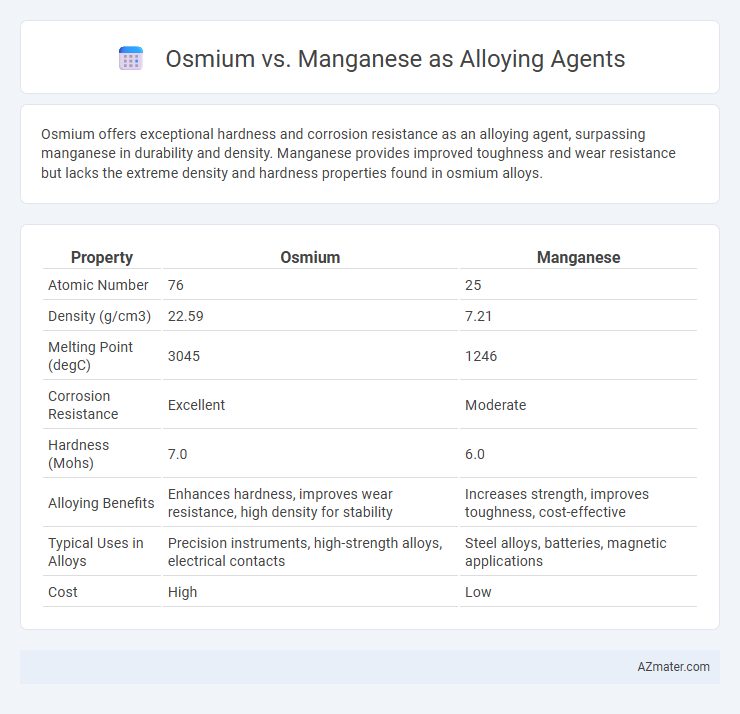Osmium offers exceptional hardness and corrosion resistance as an alloying agent, surpassing manganese in durability and density. Manganese provides improved toughness and wear resistance but lacks the extreme density and hardness properties found in osmium alloys.
Table of Comparison
| Property | Osmium | Manganese |
|---|---|---|
| Atomic Number | 76 | 25 |
| Density (g/cm3) | 22.59 | 7.21 |
| Melting Point (degC) | 3045 | 1246 |
| Corrosion Resistance | Excellent | Moderate |
| Hardness (Mohs) | 7.0 | 6.0 |
| Alloying Benefits | Enhances hardness, improves wear resistance, high density for stability | Increases strength, improves toughness, cost-effective |
| Typical Uses in Alloys | Precision instruments, high-strength alloys, electrical contacts | Steel alloys, batteries, magnetic applications |
| Cost | High | Low |
Introduction to Alloying Agents: Osmium and Manganese
Osmium and manganese serve distinct roles as alloying agents, with osmium prized for its extreme hardness and corrosion resistance in specialized applications such as electrical contacts and fountain pen nibs. Manganese enhances steel by improving hardness, tensile strength, and wear resistance, making it essential in construction and automotive industries. The selection between osmium and manganese depends on desired properties like durability, cost, and application environment.
Chemical and Physical Properties Comparison
Osmium exhibits high density (22.59 g/cm3) and exceptional hardness, making it suitable for wear-resistant alloys, while manganese, with lower density (7.43 g/cm3) and moderate hardness, provides enhanced toughness and corrosion resistance in steel alloys. Chemically, osmium's inertness and high melting point (3045degC) contrast with manganese's more reactive nature and lower melting point (1246degC), influencing their roles in alloy formulations. The distinct atomic structures and bonding characteristics of osmium and manganese directly impact their effectiveness in modifying mechanical and chemical properties of metal alloys.
Availability and Abundance in Nature
Osmium is an extremely rare platinum-group metal with a crustal abundance of approximately 0.001 ppm, making it one of the least available metals for alloying purposes. In contrast, manganese is significantly more abundant, with an average concentration around 950 ppm in the Earth's crust, enabling widespread industrial use in steel production and other alloys. The scarcity of osmium imposes higher costs and limited large-scale applications, whereas manganese's abundance makes it an economically viable and accessible alloying agent.
Alloying Behavior and Mechanisms
Osmium exhibits high density and melting point, promoting enhanced hardness and corrosion resistance when alloyed, primarily through solid solution strengthening and grain boundary stability. Manganese contributes to alloying by improving tensile strength and toughness via deoxidation and the formation of stable carbides or intermetallic compounds. The alloying mechanisms of osmium rely on atomic size mismatch and electron concentration effects, whereas manganese influences phase transformations and inclusion control in steel alloys.
Impact on Mechanical Strength and Hardness
Osmium significantly enhances the mechanical strength and hardness of alloys due to its extreme density and high melting point, making it ideal for applications requiring superior wear resistance and durability. Manganese contributes to alloy toughness and tensile strength by promoting grain refinement and improving hardenability, especially in steel alloys where it balances ductility and strength. The choice between osmium and manganese depends on the targeted mechanical properties, with osmium offering unparalleled hardness and manganese providing cost-effective strengthening and improved impact resistance.
Corrosion Resistance: Osmium vs Manganese
Osmium exhibits exceptional corrosion resistance due to its dense atomic structure and high oxidation state stability, making it highly effective in harsh chemical environments. In contrast, manganese provides moderate corrosion resistance but is more prone to oxidation and degradation when exposed to acidic or saline conditions. Alloys containing osmium demonstrate superior durability and longevity in corrosive applications compared to manganese-based alloys.
Effects on Electrical and Thermal Conductivity
Osmium significantly enhances the electrical and thermal conductivity of alloys due to its high electron density and superior thermal transfer properties, making it ideal for applications requiring efficient heat dissipation and electrical performance. Manganese, while beneficial for mechanical strength and corrosion resistance in alloys, tends to reduce electrical and thermal conductivity because of its electron scattering effects. The combination of osmium with base metals yields alloys with improved conductivity, whereas manganese's impact generally prioritizes structural integrity over conductive efficiency.
Common Industrial Applications
Osmium, known for its extreme hardness and high density, is primarily used in high-wear applications such as fountain pen tips, electrical contacts, and other precision instruments requiring exceptional durability. Manganese is widely utilized in steel production to improve hardness, toughness, and corrosion resistance, making it essential in construction, automotive manufacturing, and infrastructure projects. Industrial alloys containing manganese are critical for enhancing performance in tools, pipelines, and railroads, while osmium's niche applications focus on specialized equipment demanding superior wear resistance.
Environmental and Health Considerations
Osmium poses significant environmental and health risks due to its toxicity and the production of highly poisonous osmium tetroxide during alloying processes, requiring careful handling and strict safety protocols. Manganese, while essential in steel alloys for improving strength and durability, can cause neurological problems upon excessive exposure, primarily through inhalation of dust or fumes in industrial settings. Selecting manganese over osmium for alloying generally offers a safer and more environmentally manageable option, though both metals demand proper occupational controls to mitigate health hazards.
Cost-Effectiveness and Future Prospects
Osmium, known for its extreme density and hardness, is significantly costlier than manganese, making it less practical for widespread alloying despite its superior wear resistance. Manganese offers excellent cost-effectiveness due to its abundance and ability to improve steel strength, toughness, and corrosion resistance, driving its dominant use in industrial alloy production. Future prospects favor manganese as advancements in metallurgical processes enhance its performance, while the scarcity and high cost of osmium limit its use to specialized, niche applications.

Infographic: Osmium vs Manganese for Alloying Agent
 azmater.com
azmater.com